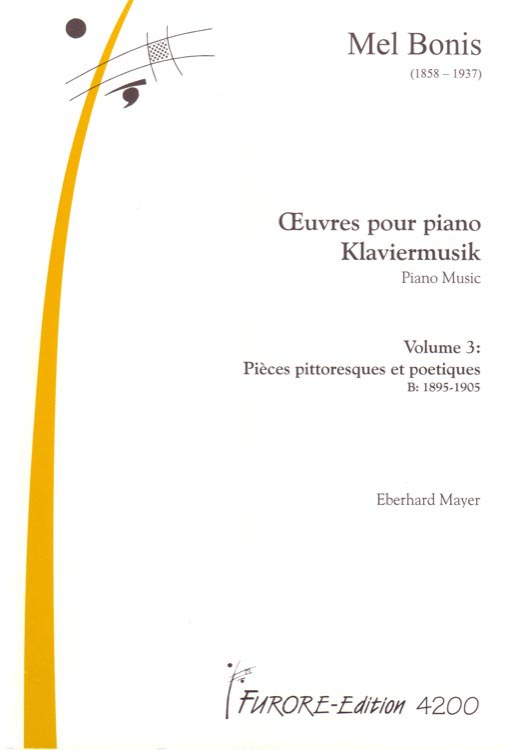Description
OEuvres pour piano/Klaviermusik/Piano Music
Edition en 10 recueils/Edition in 10 Bänden/Edition in 10 volumes
Volume 3: Vol. 3: Pieces pittoresque et poetiques B: 1895 – 1905
Instrumentation: piano
Edition: score
Publisher: Eberhard Mayer
Difficulty: medium
Contents:
La chanson du rouet op. 24
Papillons op. 28
Romance sans paroles en la bémol majeur op. 29
Méditation op. 33,1
Marionnettes op. 42
Carillons mystiques op. 31
Barcarolle en si bémol majeur op. 41
Sorrente op. 61
Le Moustique op. 66
The pieces for piano represent a great stylistic variety. One gets the impression that Mel Bonis may have intended to give a summary of musical development, not quoting historic styles but adapting the past through her personal tone and to translate it into contemporary musical language.
The second volume of Pièces pittoresques et poétiques contains nine pieces, which has been composed after 1895:
La chanson du rouet (“ The spinning wheel song”) (1895) op. 24
A rapid succession of uniform triplets in the right hand requiring speed and stamina represent the work of the spinning wheel. The piece was first published by Leduc.
Papillons (« Butterflies ») (1897) op. 18
This piece was also published by Leduc in 1897 and lasts about three minutes. Its merry six-eight rhythm and its alternation between high and low positions and be-tween major and minor remind one of the fluttering flight of butterflies in the light of a summer’s day.
Romance sans paroles en la bémol majeur (“Song without words in A flat major”) (1897) op. 29
This piece is of medium difficulty. It was first published by Leduc and lasts a good 3 minutes. The melodic lines begin in the left hand and then alternate constantly from one hand to the other.
Méditation (1898) op. 33,1
First edition published by Leduc. Méditation is dedi-cated to Jeanne Monchablon, a close friend of the com-poser’s. This purely romantic, lyrical piece creates an atmosphere of inwardness and, without being technically demanding, requires great sensitivity in execution. Mel Bonis also published a version for cello (or violin) and piano with the same publishers at the same time. 100 years later, in 1998, the latter version was reprinted by the publishers Armiane (Versailles).
Marionnettes (1899) op. 42
Due to its flowing tempo (allegro molto), this piece, with a playing time of little more than two minutes, requires a particularly light touch and dexterity in execu-tion in order to lend expression to its motion, its gaiety, its contrasts and its drollery. One finds oneself involun-tarily comparing the piece with Moustique. Marionnettes was first published by Eugène Demets in Paris in 1899.
Carillons mystiques (“Mystical carillons”) op. 31
A four-bar phrase recurring on an ostinato bass through-out the entire duration of the piece is reminiscent of a carillon. With frequent modulations and ornamental variations in the right hand, it reproduces the wide range of sound of the carillon, finally coming to rest and re-turning to the key in which it opened. „Carillons maystiques“, dedicated to Raoul Pugno, a famous Pari-sian pianist of the day, was first published in 1898 by Alphonse Leduc. The piece is of medium difficulty and lasts about three minutes.
Barcarolle en si bémol majeur (in B major)
op. 41, posthumous
Mel Bonis obviously did not intend „Barcarolle“ for publication. Yet, despite the composer’s critical attitude towards certain parts of the piece – which can be seen from her cutting out the middle section in D major and her note “MAUVAIS” (“bad”) – she still kept the manu-script. In spite of these reservations on the composer’s part, we discover a very well written first theme and an interesting musical development. „Barcarolle en si si bémol majeur“ is undoubtedly the first of the four „Bar-carolles“ that Mel Bonis composed. The manuscript was written in 1899, the year in which „Barcarolle Etude“ op.43 (see Pièces de concert) was also published by Leduc . The third is „Barcarolle en mi bémol“ op. 71 dated 1906 (see Pièces de concert) and the last, „Barca-rolle en sol bémol“ op. 134 remains only in the form of a draft from the year 1930 containing the note: „The manuscript is at Eschig“ (where we looked for it in vain). The piece lasts four minutes and is technically not easy to play.
Sorrente op. 61
“Sorrente” is a “mélodrame en miniature” – an art form that was very popular at that time. An emphatic love poem, “Sorrente”, by Cécile Guinand, is embellished with underlying romantic-impressionistic sounds, re-flecting the emotions of the poetess. It is not known if Cécile Guinand is a relation of Edouard Guinand, whose poems were very popular among composers of the day. Mel Bonis set several of his poems to music. “Sorrente” was first published in 1904 by Demets in Paris.
Le Moustique („The Mosquito“) op. 66
Le Moustique is a short but extremely effective piece that only resembles a children’s piece at first sight. In fact the performer needs a combination of technical skill and interpretational maturity to reproduce this slightly humouristic, naturalistic image of the buzzing and in-sidiously biting mosquito at the required tempo. The first edition was published in 1905 by Demets in Paris, and in 1993 it was included in the collection “Six pièces pour piano” published by Henry Lemoine. It is dedicated to the young pianist Camille Decreus who was close to the generation of the composer’s children in age.









